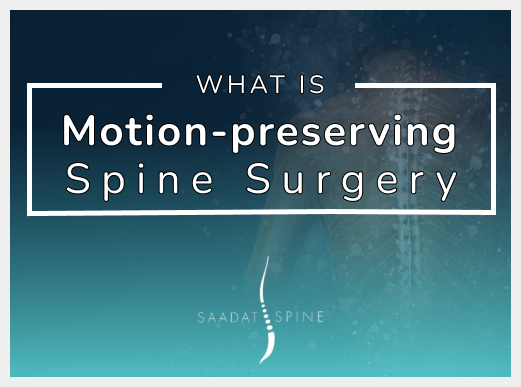The human spine is made up of 33 “motion segments” divided into the cervical, thoracic, lumbar and sacral areas. Motion-preserving surgery aims to keep these segments flexible.

The cervical and lumbar regions of the spine are mobile, allowing for the flexibility of the neck and the lower back, and activities such as bending, turning, and twisting.
Traditional surgical approaches to the cervical and lumbar spine often involve a fusion operation, where the surgeon eliminates the motion of one or more of the motion segments.
This, in turn, can render the spine stiff, and, in the long run, can result in degeneration of the adjacent discs, causing new compression on the spinal cord or the nerve roots. This process, referred to as adjacent segment disease, may require additional surgery.
Motion-preserving spine surgery refers generally to surgical options for the cervical and lumbar spine where a traditional fusion is avoided, and the natural motion of the spine is preserved.
Book your appointment with Los Angeles spine surgeon Dr. Ehsan Saadat.
Dr. Saadat is currently accepting new patients. Click below to schedule your appointment online, and get on the path to improved function and less pain.
The 2 Most Common Motion-Sparing Cervical Spine Surgery Options
There are two types of motion-preserving surgery that surgeons utilize for the cervical spine. The first, cervical disc replacement, is for discs compressing on nerve roots. This type of surgery may also include a spinal fusion. However, the second, known as a posterior cervical laminoplasty, that widens the spinal canal and doesn’t require a fusion. Here’s an overview of both procedures, how they work, and what recovery looks like.
1. Cervical disc replacement
One of the traditional, and widely accepted, techniques in addressing cervical disc degeneration and stenosis is an anterior cervical discectomy and fusion (ACDF) operation.
In this operation, the surgeon removes the degenerative disc causing spinal cord or nerve root compression. They also perform a fusion, which involves placing bone graft and/or implants in the disc’s original spot for stability.
A fusion operation renders the segment stiff and reduces the spinal motion. One of the observed consequences of a cervical fusion operation is that, over time, the adjacent discs can break down, causing new compression on the spinal cord or the nerve roots.
A disc replacement operation, on the other hand, can effectively remove the degenerative disc that is causing spinal cord or nerve root compression, while preserving the motion of the spinal segment. This, in turn, eliminates additional demand from the other discs in the cervical spine. Moreover, it can reduce the risk of future disc breakdown at the other healthy discs.
Also, a cervical disc replacement eliminates the potential issues associated with the need for a bone graft for spinal fusion and allows for early postoperative neck motion. In fact, most surgeons perform cervical disc replacements on an outpatient basis. This means patients often return home the same day or after a one-night stay in the hospital.
Limitations for arthritis
It is important to remember that a disc replacement is a motion-preservation procedure and not a motion-creation procedure.
This means that a severely arthritic segment that did not move before disc replacement is not likely to move after disc replacement. In fact, for patients with severe facet arthritis and neck pain in addition to arm pain, an anterior cervical discectomy and fusion might be a more suitable surgical option.
RELATED: Lower Back Pain: Is Artificial Disc Replacement an Effective Treatment Option?
2. Posterior cervical laminoplasty
A laminoplasty is a surgical procedure that enlarges the spinal canal.
For patients with severe spinal cord compression at multiple levels, who also have normal neck alignment and minimal neck pain, a laminoplasty offers a motion-sparing technique for spinal cord decompression. Similar to the lumbar spine, the “lamina” creates a rigid “roof” over the spinal canal.
During a laminoplasty, the surgeon creates a hinge on one side of the lamina, and wedges open the other side with the aid of a small metallic plate.
This creates more room for the spinal cord without necessitating a fusion. Most patients will notice immediate relief of arm pain and some improvement in hand numbness. Patients also usually need a one or two-night hospital stay prior to going home.
It is important to work on strengthening the muscles of the back of the neck after a laminoplasty, including isometric cervical extensor strengthening.
What Are the Benefits of Motion-Preserving Spine Surgery?
While every case is different, many patients experience a variety of benefits following a motion-preserving procedure. This includes:
- Less pain,
- Spared range of motion,
- Maintained flexibility,
- Short recovery time, and
- Reduced risk of further disc degeneration.
The major benefit of motion-sparing surgeries is that they help prevent future issues with other discs. This means less risk of needing further spine surgery, which is a common consequence of spinal fusions. In addition, procedures like cervical disc replacement are minimally invasive meaning a lower overall risk of complications.
Discuss Motion-Preserving Back Surgery Options with Dr. Ehsan Saadat
For those who suffer from neck or back pain, preserving the flexibility of their spine is often a major concern. If this sounds like you, make sure to select a surgeon that prioritizes safety, comfort, and innovative techniques. Dr. Ehsan Saadat is a board-certified, Harvard and Emory-trained orthopaedic spine surgeon, and an Assistant Professor of Orthopaedic Surgery at Cedars-Sinai Medical Center. Him and his team at Saadat Spine are dedicated to the helping patients through the art and science of spinal surgery.
Request a consultation online or give us a call at 310-961-9820

